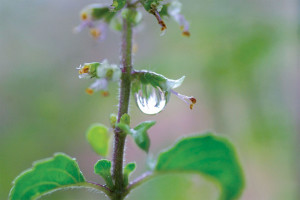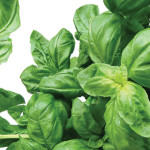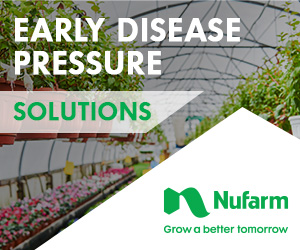Managing Air Temperatures For Basil Growth And Development

Understanding how different basil species respond to air temperatures can help increase cropping efficiency. Photo courtesy of Snap/Flickr.
When it comes to speeding up or slowing down crops, temperature is the primary factor driving the rate of growth and development of greenhouse crops. Understanding how different species respond to temperatures can help greenhouse growers increase cropping efficiency.
In the past, we have reported on how cultivars, hydroponic systems, planting density, nutrient solutions, and light affect the growth and development of hydroponically produced basil. For this final article in our four-part series focusing on basil production, we would like to discuss how air temperature influences basil growth.
Four Basil Cultivars Evaluated
We grew seedlings of ‘Nufar’ sweet basil, ‘Holy’ basil, and ‘Sweet Dani’ and ‘Lime’ lemon basil in 288-cell plug trays filled with germination mix. Three weeks after sowing seeds, seedlings were transplanted into 4-inch plastic containers filled with a commercial soilless substrate comprised of peat and perlite. After transplanting, 10 plants of each cultivar were placed into one of five environmental growth chambers maintained at 52°F, 63°F, 73°F, 84°F, or 95°F.
Plants were fertilized thoroughly once per week with a solution containing 200 ppm nitrogen from a 15-5-15 fertilizer containing micronutrients. In between fertilizations, plants were irrigated with clear water without leaching. Fluorescent lights inside of the growth chamber provided light for 16 hours per day. Three weeks after transplanting, we counted the number of plants with flowers and measured height, node, and branch number. Additionally, we measured fresh and dry mass of the basil shoots.
Increasing Air Temperature Enhances Basil Growth
The rate of growth, or increase in weight, increased as temperature increased for all four of the basil cultivars used in our study. For example, at the end of the experiment, sweet basil grown at 84°F weighed an ounce more than plants grown at 52°F. Similarly, the rate of increase in fresh mass for sweet basil increased by 0.05 ounces per day as temperature increased from 52°F to 84°F. All the cultivars had a similar response to sweet basil, with growth increasing as temperature increased. However, for all cultivars, both the final weight and rate (ounces per day) decreased as temperatures went from 84°F to 95°F.
While not of primary interest to herb producers, we did notice some variation in flowering across the different basil cultivars. Sweet basil did not flower in our experiment in any of the temperature treatments. Holy basil and ‘Lime’ lemon basil were flowering by the end of the study in some, but not all, of the temperature treatments. There was little to no sign of flowering at 52°F, and we attribute this to slow development rates due to low temperatures. As temperatures increased, flowering increased to nearly 100% at 73°F and 84°F. As temperature increased above 85°F, we saw delayed or no flowering (see Figure 1) as a result of heat delay.

Figure 1. ‘Holy’ basil grown at constant air temperatures ranging from 52°F to 95°F in environmental growth chambers. This photo was taken three weeks after placing plants into treatments.
Plant height was also affected by temperature. The height for all four cultivars increased with temperature up to 84°F. Plants grown at 95°F were slightly shorter. There are two different factors that contribute to the change in height — node number and internode length. As temperatures increase, more nodes are formed, therefore increasing plant height. In addition to recording height and node number, we also calculated internode length. Internode length increased as temperature increased from 52°F to 73°F or 84°F, depending on the cultivar.
Keep Basil Warm
How can our results help with your production? First, for all of the basil cultivars utilized in our study, plant growth (weight) and height increased with temperature in a linear relationship between 52°F to 84°F. This linear relationship means that the effect of changing the average daily air temperature should result in predictable effects on growth, as long as the temperatures remain in the linear range.
Another clear result of our study is that basil grows well at warm temperatures. As temperature increased from 84°F to 95°F, growth started to decline, though not severely. Although greenhouse producers will likely not increase their temperatures to the warmer temperatures used in our study during the late fall, winter, and early spring (the heating season), our results support the potential for increasing basil production during the summer months, when warm greenhouse temperatures may diminish the growth of some crops — but not basil.
On the other end of the temperature spectrum, avoid low temperatures when growing basil. First, the growth of all four cultivars used in this study was minimal at 52°F. At low temperatures, the slow growth would increase crop time and reduce profitability due to increased production time. Additionally, plants were stressed, and with some plants, there was visible damage from the cold temperatures, which would decrease yields.
Take-Home Messages For Basil Production
The biggest take-home from our study is that basil is a warm-growing crop that is sensitive to cold temperatures. Although many greenhouse growers will not be heating the greenhouse to the mid-80s during the winter, our research should encourage growers to avoid cool or cold temperatures so crops are not delayed. Alternatively, basil would be a prime candidate for summer production in greenhouses, as temperatures that would be problematic for some crops suit basil well. Growers should always perform in-house trials to evaluate responses under their own greenhouse environment and culture.
In Case You Missed It
How To Choose The Right Hydroponic Production System For Growing Basil
Increase Planting Density To Increase Hydroponic Basil Yields
Managing Electrical Conductivity (EC) For Hydroponic Basil Production









